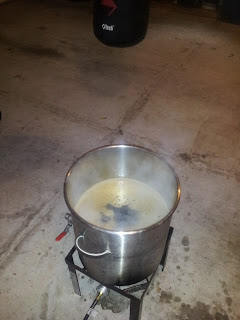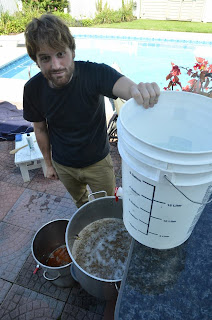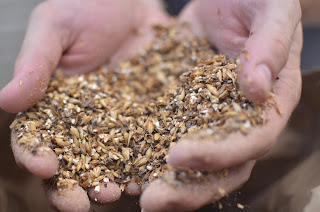I normally start these entries off with stating things like,
‘a lot has happened,’ or, ‘I’ve been so busy.’ I figured some things needed to
change since I could hear every person that ever educated me on writing
screaming criticism at my repetition. This being the case, shit is going to
change. It’s about time to mix some things up, and luckily, some events have
made it much easier to do so.
Rather than follow chronological order of beers brewed, I’m
starting where I want this time. The main reason for this is because I
was made aware this past week that people read this. That is pretty fantastic,
but I feel like I owe the people that get here at least a little more ease of
readability. I will be dropping a bit of the technical-speak, as well as some
of the pointless details—again, to avoid being redundant. I might even try to make
the brewing process look a bit more accessible to other people. Essentially,
I’m going to try to start making this public notation more ‘public friendly.’
We’ll see how it goes.
Moving on, the piece of news that has me more excited than
any of my beer ideas is the future of this hobby. I had a brilliant weekend
catching up with good friends, both those I see regularly and those I haven’t
seen in ages. Amidst good company and good drinks I was hit with the blatent
realization that I know a lot of people in very convenient places. To make a
long story short, I have commercial openings for serving beer. I’ve just got to
flaunt the feathers a bit, and prove that I’ve got the skills to sell something
worthwhile.
This is usually the point where I hit a downward slope of a
bell-curve. Whenever I’ve taken a hobby to an heavily competitive/intense
level, it usually chars the whole experience, and ‘ruins’ it for me. I had
always come out feeling like I had ‘lost the enjoyment,’ or that I just took it
too seriously now. All of the reasons I had originally embarked upon within the
hobby were no longer ‘pure’, but competitively or adversely motivated.
Eventually, I would just fizzle out, and slowly give less and less attention to
the practice.
In some
respects, I feel that could happen again with brewing. In others, however, I
feel it is much different. While I could go on and schpiel about how I’ve grown
over the years, and blah blah blah—that’s not what this is about. This is about beer, my experiments with
the stuff, and the potential for what my projects may become. In short, there
is no need to worry about my fizzling.
What matters from all this is that ‘the shapes of beer to come’
could be seen on the horizon. I now had venues to actually get in on the
market, and now it was a matter of deciding what I should nail down to be the
first impression. First impressions say a lot, and to jump in on an already
unique and diverse market is a bit intimidating. I felt an initial beer should
be something that displays brewing competency yet also has a distinctly unique
signature. Something classic, but with a slightly new take—something with a
personal touch.
The first thing that jumped out at me was the German Alt (or
Alt[earoa]). At first I was hesitant since a brewery in Baltimore already
opened its doors with an Alt beer (a damn good one too), but those wary
feelings passed. My recipe was different from that, and it was good. Not only was
it a solid, sessionable beer, but it had my personal, unique experience within
it. I used only New Zealand hops—To make this the first beer that goes
commercial would be an incredible honor for me. It would be my own personal
thank you, and shout out to my favorite country in the world— the place where
the whole love for, and idea of brewing for a career first entered my brain.
There is no competition. This recipe had to be done.
 |
| Look at that clarity! |
Tasting the Alt recipe right now, it is solid. Nothing wild,
nothing adventurous, just a solid, toasty malt-driven, easy drinking beer with
a hint of fruit from hops. A tiny adjustment to bring the ABV from 7% to the
5-6% range is the only fix I’m going to need. That will be easy enough.
As for the second (why two beers? You’ll see why…),
inspiration hit me while visiting the Willow bar in Fells Point. We decided to
hit up the venue after some coaxing from a friend who worked there (not really,
though. She said good cocktails, and we said why the fuck not). Our friend
began bragging about a cocktail she had invented, and after a few featured
ingredients, I took a strong interest. When I pulled out my phone to record the
list, I was quickly accused of potential plagerism. Understandable, but I
quickly waved it off, simply stating, ‘I’m not gonna steal it, I’m gonna make
it a beer.’
This garnered some serious enthusiasm, eventually materializing
into another potential spot to host my product. Though it wasn’t verbally
stated, I saw this opportunity as a challenge. I needed to make this cocktail successfully into a beer. What would
be better than to have the first beer served at the joint to be a reflection of
a cocktail invented by a staff member?
Plus, this shit would be FUN
 |
| It was either this or the jalapeno wonder that I fell in love with. Believe me the decision was VERY hard |
The cocktail has no name—as far as I’m aware. There was talk
of something Simon and Garfunkel related, mainly because of the rosemary
involved (e.g. ‘Scarborough Fair’). Regardless, it is gin-based, with a
balancing dose of grapefruit, garnished with a spring of rosemary, which was
briefly lit on fire. What came out
the other end was a pleasantly fruity drink with a nice bouquet of rosemary and
fruit, with a touch of smoke.
It took me very little time to figure out how to approach
it. There was no other style I could think of that could deliver that variety of
flavors other than a Saison. This would be a very different one however, and so
I had to go a little outside of what I knew of the style. To get the gin
flavor, I used the Gotlandsdricka technique of juniper-infused sparge water.
For the grapefruit, I used the zest of a grapefruit as well as the juice near
the end of the boil. I also used Simcoe hops to bring out a bit more of the fruit
characteristic. Rosemary was added during the boil for aroma and a hint of
flavor, and I added a very small, very conservative quantity of smoked malt to
the profile.
In terms of yeast it was a toss up between two different
ones. I eventually settled on making a 30L batch and splitting it into two 15L
fermenters. One had a Belgian Saison blend yeast—my experience’s suggestion—and
the other has an American Farmhouse blend—my adventurer’s suggestion. I’m
actually hoping the Farmhouse blend wins out. It contains a bit of brettanomyces,
which I think will help lend to the cocktail-nature of the recipe with a tinge
of sour.
 |
| Guess which one is 'infected' with Brett.... |
Both are fermenting well, but since both have Saison
strains, they will be fermenting for a long-ass time. For some downsides,
however, there is sometimes and upside. I have also found—quite recently—that
Belgian yeast strains benefit heavily from a little extra aging.
The discovery was made while raiding my beer fridge. I came
across a few bottles of the ol’ Tarakena Summer Ale I did back in August. I
thought I’d give it another go, and poured one from a bottle. My mind was blown
in an instant. The Belgian character that had previously overpowered all the
other flavors had subsided, and became a background characteristic. Everything
else I put into the beer was on prominent display: the mint, chamomile, and
ginger were in perfect balance, adding, a nice complexity to the beer, but not overpowering
it in any way. I actually found it hard to believe I made the damn thing. I
have two 335ml bottles left in the fridge, and I’m afraid to touch them. They
will definitely be opened for the New Years dealie, and I will definitely be
brewing that recipe again. Patience pays off.
 |
| Sexy, sexy, patience |
And nothing has tested my
patience more than the #3 Wheat wine. I’ve decided to give this one the benefit
of the doubt—in terms of aging—and just try not to pay any attention to how
badly I want to taste the finished product. It fermented damn well, finishing
around 10.6%. It still is not as high as I wanted it, but now that I’ve found
the secret to mash efficiency, I’ll definitely be doing this recipe again.
After about 12 days in a secondary fermenter I emptied out the Sauvignon Blanc
barrel, and transferred the juicy, beer-y deliciousness into the Tough Guy
cask. I took little sips of it every day, and actually needed to transfer it
out after only 3 days.
I knew that the barrel would
infuse the beer with more than enough flavor in a very short amount of
time—freshly made oak barrels do that. But I was expecting the Sauvignon Blanc
seasoning to suck out at least a bit more of that raw oakiness. After all, the
Sauv was undrinkable by the time I put the Wheat Wine in its place. All in all,
though, the length of time doesn’t matter. I wanted the flavor, and its there.
The Wheat Wine is now sitting in a purged keg for aging. I’ll probably tap it
in another week or so.
 |
| That is one happy Tomcat |
As for the other wheat wine
(#2), I unfortunately encountered a noticeable diacetyl presence during a
recent glass. I’m a little disappointed, but to be completely honest not too
surprised. I rushed the hell out of that beer, partially because in my mind, I
had already failed to get what I wanted. It is still a solid Wheat-IPA, but it
is also out of style, not what I intended, too hoppy, and now has diacetyl. End
result: enjoyable, but still disappointing.
 |
| At least it looks pretty |
It was, however, a learning
experience that I took advantage of very quickly. I wanted to prevent the
Russian Imperial Stout (RIS) from obtaining the same buttery diacetyl taste, so I tossed in
some champagne yeast to clean up any remnants the other yeast left
behind. It also wouldn’t hurt to get a little boost in the ABV area, since the
RIS is currently sitting around 9.6% (out of a potential 11%). I
could have been a bit more generous with the grains to ge the ABV, but that is an easy fix for the next batch.
 |
| With a little extra booze, this will be a proper RIS. На здоровье! |
This ‘easy fix’ is of course due
to the new mash technique. I gambled a bit with the cocktail-style-saison,
essentially betting the entire recipe on the idea that I would hit around the
same efficiency as the RIS (e.g. 80%). I repeated the process in the exact same
manner, near identical temperatures and—wouldn’t you know it—it came out at
81%. For the second time in a row, the mash worked out in an amazingly
brilliant manner.
To put this as easily as I can,
rather than get grains and aim(/hope) for a general area of ABV, I can now get
EXACTLY what I want based EXACTLY on how much grain I use. The only factor that
I need to have a better control over is getting a more thorough control over
the yeast performance. Once that is handled, the only limitation to me making
something precisely as I imagine it is to know my ingredients better.
This. Is. So. Awesome.
To top off this child-like
excitement, I tapped the Coffee Vanilla Brown ale a few days ago. It is a
dessert beer and a half. The malt profile already gave it great toffee,
caramel, and hints of chocolate. That combined with the addition of the vanilla
and the Jamaican coffee was just too much—too much in a really REALLY great
way. The coffee also had some caramel notes, and gave a nice roasty touch to
the beer, and the vanilla smoothes out all the ‘harsher’ flavors. The damn thing
tastes like a cake. A delicious, boozy (8%), cake. If I ever make a brown ale
commercially, I will definitely be choosing this variation. It may be worthy
of being called a ‘holiday beer’.
In the end, the brewing lately has been a hell of a great time. I'm currently in light talk for a '5 Year Plan' for what will be referred to as Project TGT. I'm in the research phase at the moment, but as of now it is looking very feasible to start contract brewing, and soon turn the 'project' into something more. This is truly exciting stuff. But for all the excitement, I have to remind myself the lesson that I learned from brewing this week. I believed myself patient before, but I still need to increase my discipline. With sparging, fermentation, aging, and now with contracting, patience is is key.
I'm still young. And I need to remind myself of this on a daily basis. I tend to rush things if I dont.
Wingfield's 'Willow'
Belgian Pilsner, White Wheat, Vienna, German Rauchmalt
Simcoe
American Farmhouse (WLP670), Belgian Saison Ale Yeast (WLP568)
American Farmhouse (WLP670), Belgian Saison Ale Yeast (WLP568)
Juniper Berries, Rosemary, Grapefruit (Zest/juice),



































